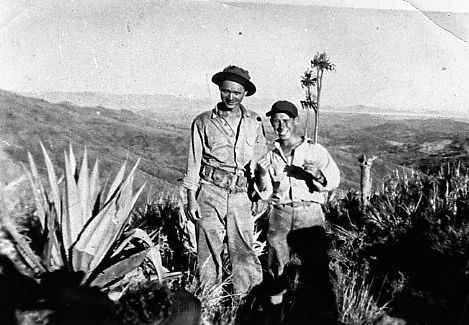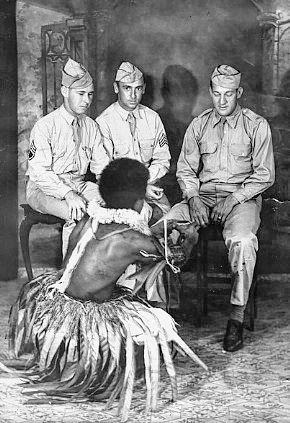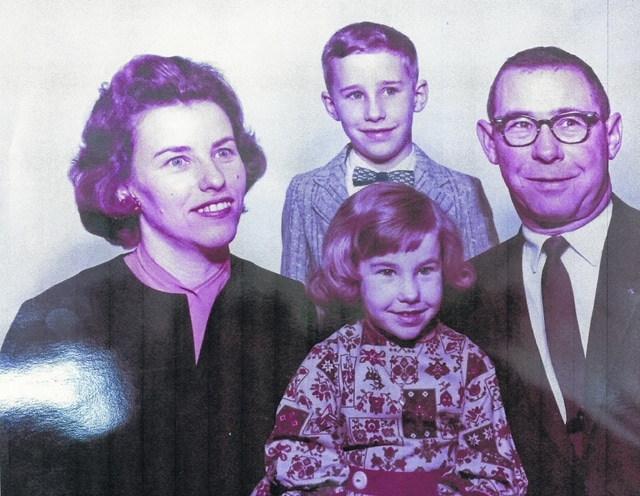


As we observe Veterans Day 2015, families and friends of the members of the Ohio National Guard, Company I, 148th Infantry, 37th Division, (Buckeye Division) from Sidney and the surrounding area, who trained at the Sidney Armory, as well as the 136th Field Artillery, 2nd Battalion, Headquarters Battery of the 37th Division, who trained at the Piqua Armory, will be interested in a World War II history lesson, either forgotten or never learned.
We will begin with background of the campaign and the involvement of the National Guard.
Leading up to Japan’s attack on Pearl Harbor
Since early 1941, the United States and Japan had been engaged in negotiations in an attempt to improve their strained relations and end the war in China. During these negotiations, Japan advanced a number of proposals which were dismissed by the Americans as inadequate. Roosevelt reinforced the Philippines, an American protectorate scheduled for independence in 1946, and warned Japan that the U.S. would react to Japanese attacks against any “neighboring” countries.
Frustrated at the lack of progress and feeling the pinch of American-British-Dutch sanctions, Japan prepared for war. On Nov. 20, 1941, it presented an interim proposal as its final offer. It called for the end of American aid to China and the reestablishment of the supply of oil and other resources to Japan. In exchange, Japan promised not to launch any attacks in Southeast Asia and to withdraw its forces from their threatening position in southern Indochina. The American counterproposal of Nov. 26, 1941, required that Japan evacuate all of China without conditions and conclude nonaggression pacts with all Pacific powers. That meant Japan was essentially forced to choose whether to abandon its ambitions in China or to seize by force the natural resources it needed in the Dutch East Indies.
Japan planned to rapidly seize European colonies in Asia to create a large defensive perimeter stretching into the Central Pacific. The Japanese would then be free to exploit the resources of Southeast Asia while exhausting the overstretched Allies by fighting a defensive war. To prevent American intervention while securing the perimeter, it was further planned to neutralize the United States Pacific fleet and the American military presence in the Philippines from the outset. On Dec. 7, 1941, Japan attacked British and American holdings with almost simultaneous offensives against Southeast Asia and the Central Pacific. These included an attack on the American fleet at Pearl Harbor, landings in Thailand and the Malay Peninsula, and the battle of Hong Kong.
These attacks led the United States, Britain, China, Australia and several other states to formally declare war on Japan.
37th Ohio National Guard Infantry Division
The division’s history dates from July 1918, when the unit received its official authorization and designation from the federal government several months after America’s entry into World War I.
As early as 1939, with the threat of another world war, the Ohio National Guard found itself in a moderate state of readiness under the leadership of Maj. Gen. Robert S. Beightler. When President Franklin D. Roosevelt declared a state of emergency and brought the National Guard under federal control in October 1940, the Buckeye division was among the ranks.
Beightler was one of 11 generals who commanded their divisions for the entire war and was the only National Guard general to do so.
Members of the Company I, 148th Infantry (Rifle), 37th Division, met at the Sidney Armory (now the site of the Senior Center of Sidney-Shelby County) and a number of Sidney men trained under the leadership of well-known Sidney businessmen, including Attorney Frank “Jumpy” Marshall, 2nd Lt. Merton Maxwell, Lt. Col. Clyde Millhoff, Roscoe Stump, 1st Lt. Arthur Tremain and Elwood Young. No written history could be located so their ranks may be incorrect, and there may be others that trained the men. Training took place in the evenings.
The following information was taken from the files of Emerson “Peck” Setsor, furnished by Sgt. 1st Class Joshua D. Mann, historian for the U. S. Army National Guard, and by Lloyd Cromes, who was with the artillery group and is the only surviving member of either group, the infantry or artillery.
The following persons had addresses of Sidney, Port Jefferson, Botkins, Jackson Center, Houston, Quincy or Degraff:
In Company I, 148th Infantry, 37th Division were Harold E. Boyer, Raphael E. Brown, Carl R. Cook, Clarence Deal, LeRoy L. Elliott, Orin Fogt, Robert H. Fogt, Martin T. Foster, Herbert C. Francis, Harold I. Gierhart, Marion L. Graham, George T. Hasbrook, William Hasbrook, Lloyd E. Hittepole, Emory R. Ludwig, Wallace W. Masteller, Herbert D. Neer, Jack W. Nichols, Jacob Piatt, Claude L. Reeve, Dwight Richards, Carl E. Schaffner, Emerson E. Setsor, Woodrow F. Sitzman, Dan L. Strohl, Wilbert J. Swiger, Lester W. Valentine, Charles W. Walker, Bernard E. Watren, Elmer L. Watren, Marvin R. Woolley and Ervin G. Zorn.
136th Field Artillery, 2nd Battalion, Headquarters Battery, 37th Division
In the 136th Field Artillery, 2nd Battalion, Headquarters Battery, of the 37th Division were Robert L. Allinger, Francis Leo Applegate, Richard M. Clark, Charles H. Clayton, Robert H. Cook, Lloyd V. Cromes, Leonard Drees, Harvey M. Edwards, Theodore G. Flinn, Bernard B. Gasaway, Joseph E. Gattes, Wayne E. Hanselman, Milton G. Jacobs, Ralph M. Johnson, Victor W. Johnston, Otis Kah, Leonard Kerns, John Kiser, Jr., Carl O. LeFevre, Rich Minton, Gerald Molitor, Ralph R. Munger, Rodney L. Oldham, Omar L. Patton, Wilbur Piper, Jr., Gerald R. Ringlespaugh, Leonard F. Ringlespaugh, Clarence E. Roberts, Harold E. Scherer, Darwin R. Schiff, Carl F. Sexauer, Paul E. Starrett, Robert Dean Torrence, Henry Walburn, Charles R . Wheeler and Charles C. Williams.
Not all men in the 136th Field Artillery were assigned to the South Pacific; some went to Africa and others to the European theatre. One such assignment to Europe was Clarence Roberts, who participated in the Battle of the Bulge. His son, Paul Roberts, of rural Fort Loramie, said that his dad recalled that on Dec. 24 at midnight, the shooting stopped. For about two hours on that Christmas Eve, the German, American and American Allied troops sang Christmas carols. Paul remembers that more than once his dad shed tears on Christmas Eve, because he had a hard time when he remembered he had survived the battle when other soldier brothers were killed during this time. Clarence was a warrant officer in communications, and when he returned to Sidney, he worked for many years for United Telephone Co. Paul’s son and Clarence’s grandson, John Roberts, also served in the Ohio National Guard.
Buckeye division in action
Oct. 20, 1940, the first Buckeye division troops left Ohio for Camp Shelby, Mississippi, and the rest of the 37th followed a few days later. On arrival, the troops had to build much of the camp themselves before they could begin training exercises. About 9,000 soldiers went to Camp Shelby from Ohio, and in the succeeding months they were joined by 10,000 selectees sent from the state to bring the division to full strength. Intense training and maneuvers followed throughout much of 1941.
On Feb. 18, 1942, the men in Company I that remained at Camp Shelby were sent to Indiantown Gap at Harrisburg, Pennsylvania.
In April 1942, the men boarded a train for San Francisco. They left San Francisco for New Zealand on the ship, President Coolidge, on May 26, 1942.
On June 11, 1942, they arrived in the Fiji Islands, with a mission to fortify the islands.
On April 5, 1943, they moved on to Guadalcanal.
On July 21, 1943, the division landed on Kokorana Island in the Solomons and arrived on New Georgia on July 22, 1943, and all elements reverted to its control, including battalions from the 14th Infantry and the 145th Infantry that were attached to the 1st Marine Raider Regiment for operations on New Georgia Island. Munda Airfield was seized on Aug. 5, 1943, and the division pushed across the island and conducted combat patrolling. Leroy Elliott was wounded on July 8, 1943, on New Georgia, and died from those wounds on July 17, 1943, and received the Silver Star award posthumously.
Bob Elliott, of Sidney, never knew his father, LeRoy, who was the first casualty for Company I on New Georgia. Bob’s knowledge of his father is from pictures and the letters about him shared by his grandparents, aunts and uncles. LeRoy’s sisters, Wilma Carnes and Phyllis Elliott, and his brother Phillip Elliott told Bob stories about his father. The sadness LeRoy’s siblings felt when they learned of LeRoy’s death is still very vivid to them. They said their parents, Ferris and Margaret Elliott, were never able to accept their son’s death.
On Sept. 9, 1943, after mopping up on New Georgia, the division returned to Guadalcanal and were attached to the Marine Corps.
On Nov. 8, 1943, the division arrived at Empress Augusta Bay on Bougainville Island and was followed by the 129th and the 145th infantries. Relieving the Marines there, the 37th Infantry Division took over the area perimeter defense, expanded the western beachhead sector, constructed roads and bridges, engaged in extensive patrol activity and repulsed eight Japanese divisional attacks during March 1944, including the March 8, 1944, counterattack on the famous Hill 700. In April, patrols cleared the Laruma Valley area of major enemy units. The division remained on Bougainville until December 1944.
Infantryman remembers
On Dec. 18, 1944, the division landed at Huon Gulf, New Guinea, and Manus Island, enroute to the Philippines. They were a part of the 1st Marine Amphibious Corps (1st MAC). 1st MAC was relieved by the XIV Corps, to which the 37th Division was then assigned. Frank E. Foreman of Iowa, Louisiana, was a medic with Company I, 148th Infantry.
“It might be interesting to you folks to know how we felt at the time that we were getting ready to go on our last campaign,” he said. “We had been in combat areas for two and a half years already and were being told that the next objective would be the Philippines and the city of Manila. Having been in combat already on New Georgia and also on Bougainville, we were not all that anxious to tackle another island.
“We had been told to expect 20 to 30 percent casualties during the operation on Luzon, and that turned out to be about right.”
Foreman said 15 or 20 members of the company decided to have a party, pooling their money to buy liquor from the seabees at the air strip.
“I often think now of those times, because some of those at the party, including Lester (Valentine), did not make it back (from the war).”
On Jan. 9, 1945, the division landed with the Sixth Army on the beaches of Lingayen Gulf, Luzon, and the 37th raced inland to Clark Field and Fort Stotsenburg, where fierce resistance delayed capture of those objectives until Jan. 31, 1945. The division continued the drive to Manila and entered the city’s outskirts on Feb. 4, 1945. Upon crossing the Pasig River, it ran into bitter Japanese opposition. In heavy street fighting, American and Filipino troops cleared the city by March 3, 1945.
After garrison duty in Manila from March 5 to March 26, the division shifted to the hills of Northwest Luzon, where heavy fighting culminated in the capture of Baguio on April 26. Rest and rehabilitation during May were followed by action in June in the Cagayen Valley against deteriorating Japanese resistance, taking Cauayan on June 16, 1945. The soldiers left Luzon on July 8, 1945. With the end of hostilities on Aug. 15, the division was concerned with the collection and processing of prisoners of war, leaving November 1945 for the home and demobilization.
Three local soldiers lost their lives on Luzon and a number were wounded. Lost were Valentine, who died Feb. 10, 1945, from wounds received earlier; Herbert Neer, who was killed in action on Feb. 19, 1945; Marion Graham, who was killed in action on May 8, 1945; and Clarence Deal and Jacob Piatt, who also are listed as killed in action and their names appear on the wall at the Monumental Building in Sidney, but it is not known in what battle and on what day they were killed.




